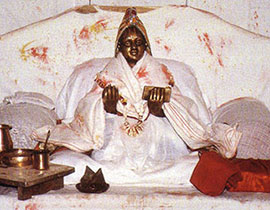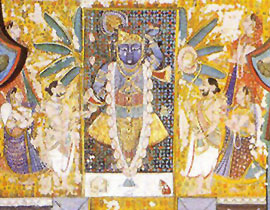The Mughal Emperors from Akbar onwards bestowed royal grants, which supported the growth of the sampradaya and established it firmly in the Braj (Mathura) region. Emperor Akbar knew Vitthaleshawar personally and held discourses with him. The famous large diamond sparkling in Srinathji’s chin is said to have been offered by Akbar. It was Emperor Shahjahan who gave the title of tilkayat to the head of the clan and to the chief goswami of Srinathji’s shrine, a title which has since come down the line. But with the advent of Aurangzeb and his growing orthodoxy and intolerance, the decision for Srinathji to leave the Braj area was taken by Tilkayat Damodarji: Srinathji and his entourage left Braj quietly on 18 September 1670 AD, heading southwards to Rajasthan, arriving in Kota first. He spent the four months of rains, chatturmas, in a thick forest near Dad Devi, now known as Charan Chowki. He then proceeded to Kishangarh and after a short while continued on to Jodhpur, staying in Chopasni. But he was nowhere sure of the safety desired. Thus the journey continued, and he sought sanctuary in Mewar under the rule of Maharana Raj Singh. As the chariot carrying Srinathji travelled to Udaipur, it got stuck at the place where Nathdwara now stands. All efforts to dislodge it were unsuccessful, and seeing this as an auspicious omen, it was interpreted to be the final abode of Srinathji. A haveli was soon erected there and the image was installed on 10 February 1672. In time a village grew around this holy spot which came to be known as Nathdwara, the "Gateway to the Lord".


